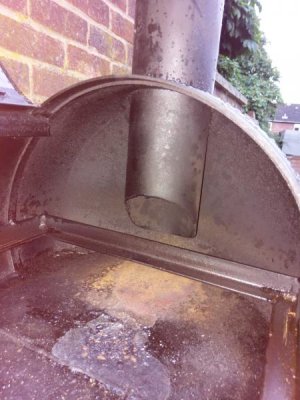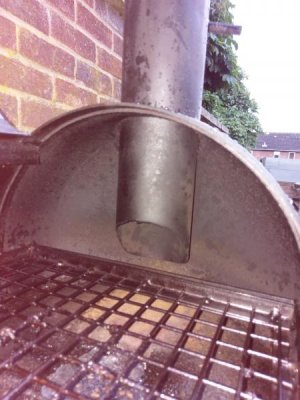Blondy_UK
Well-known member
- Joined
- Jun 6, 2017
- Location
- Daventry UK
Wow, thats a lot of response and some good sugestions.
I will try to add some more info, the wood had been gathering dust in my shed for probably 3-4 years which went onto a chimney full of glowing coals and left it to burn down and for the cook chamber to get hot before putting in the meat. At that first time i only had dial meat probe which i left on the shelf so not that accurate. I have a twin probe wireless thing now but did not arrive untill the day after my second cook.
I did look at a calculator regarding the dimensions and such and it recomended a 6 1/2" tall chimney. When i built it i thought that a larger stack would get the smoke out quicker and being that high would keep the wood smoke out of my face and off of my clothes. I think i will do another dry run and probe the chimney at different levels just to see whats going on there before i get the hacksaw out, but if thats going to help then it will have to be done.
The space at the end of the RF baffle plate is comparable with the opening to the firebox/ cook chamber ang bigger in area than the stack, i did cut a piece plate to close it of a bit as i read somewhere that it could be putting too much smoke into the cook chamber and not being able to leave quick enough.
I was getting the TBS a lot of the time but it was when i was adding wood the keep the temp up i was getting some white smoke . So was wondering if its possible to do long cooks on wood but as one of the coments said the can do 10-12 hours without wrapping. Thats what i'm after.
There are some picks on my welcome call page also whats OP mean?
I hope i have given all the extra info, there were a lot of suggestions to try but if i have missed any replys out let me know and i wil try to give more info but thanks again for all of your suggestions. Weather permitting i will be burning again at the weekend. PJ
I will try to add some more info, the wood had been gathering dust in my shed for probably 3-4 years which went onto a chimney full of glowing coals and left it to burn down and for the cook chamber to get hot before putting in the meat. At that first time i only had dial meat probe which i left on the shelf so not that accurate. I have a twin probe wireless thing now but did not arrive untill the day after my second cook.
I did look at a calculator regarding the dimensions and such and it recomended a 6 1/2" tall chimney. When i built it i thought that a larger stack would get the smoke out quicker and being that high would keep the wood smoke out of my face and off of my clothes. I think i will do another dry run and probe the chimney at different levels just to see whats going on there before i get the hacksaw out, but if thats going to help then it will have to be done.
The space at the end of the RF baffle plate is comparable with the opening to the firebox/ cook chamber ang bigger in area than the stack, i did cut a piece plate to close it of a bit as i read somewhere that it could be putting too much smoke into the cook chamber and not being able to leave quick enough.
I was getting the TBS a lot of the time but it was when i was adding wood the keep the temp up i was getting some white smoke . So was wondering if its possible to do long cooks on wood but as one of the coments said the can do 10-12 hours without wrapping. Thats what i'm after.
There are some picks on my welcome call page also whats OP mean?
I hope i have given all the extra info, there were a lot of suggestions to try but if i have missed any replys out let me know and i wil try to give more info but thanks again for all of your suggestions. Weather permitting i will be burning again at the weekend. PJ


